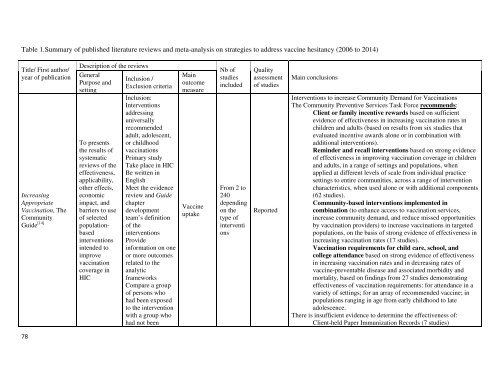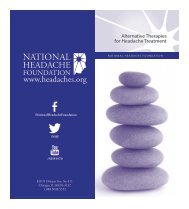2_SAGE_Appendicies_Background_final
2_SAGE_Appendicies_Background_final
2_SAGE_Appendicies_Background_final
Create successful ePaper yourself
Turn your PDF publications into a flip-book with our unique Google optimized e-Paper software.
Table 1.Summary of published literature reviews and meta-analysis on strategies to address vaccine hesitancy (2006 to 2014)Title/ First author/year of publicationIncreasingAppropriateVaccination, TheCommunityGuide [14]Description of the reviewsGeneralPurpose andsettingTo presentsthe results ofsystematicreviews of theeffectiveness,applicability,other effects,economicimpact, andbarriers to useof selectedpopulationbasedinterventionsintended toimprovevaccinationcoverage inHICInclusion /Exclusion criteriaInclusion:Interventionsaddressinguniversallyrecommendedadult, adolescent,or childhoodvaccinationsPrimary studyTake place in HICBe written inEnglishMeet the evidencereview and Guidechapterdevelopmentteam’s definitionof theinterventionsProvideinformation on oneor more outcomesrelated to theanalyticframeworksCompare a groupof persons whohad been exposedto the interventionwith a group whohad not beenMainoutcomemeasureVaccineuptakeNb ofstudiesincludedFrom 2 to240dependingon thetype ofinterventionsQualityassessmentof studiesReportedMain conclusionsInterventions to increase Community Demand for VaccinationsThe Community Preventive Services Task Force recommends:Client or family incentive rewards based on sufficientevidence of effectiveness in increasing vaccination rates inchildren and adults (based on results from six studies thatevaluated incentive awards alone or in combination withadditional interventions).Reminder and recall interventions based on strong evidenceof effectiveness in improving vaccination coverage in childrenand adults, in a range of settings and populations, whenapplied at different levels of scale from individual practicesettings to entire communities, across a range of interventioncharacteristics, when used alone or with additional components(62 studies).Community-based interventions implemented incombination (to enhance access to vaccination services,increase community demand, and reduce missed opportunitiesby vaccination providers) to increase vaccinations in targetedpopulations, on the basis of strong evidence of effectiveness inincreasing vaccination rates (17 studies).Vaccination requirements for child care, school, andcollege attendance based on strong evidence of effectivenessin increasing vaccination rates and in decreasing rates ofvaccine-preventable disease and associated morbidity andmortality, based on findings from 27 studies demonstratingeffectiveness of vaccination requirements: for attendance in avariety of settings; for an array of recommended vaccine; inpopulations ranging in age from early childhood to lateadolescence.There is insufficient evidence to determine the effectiveness of:Client-held Paper Immunization Records (7 studies)78



